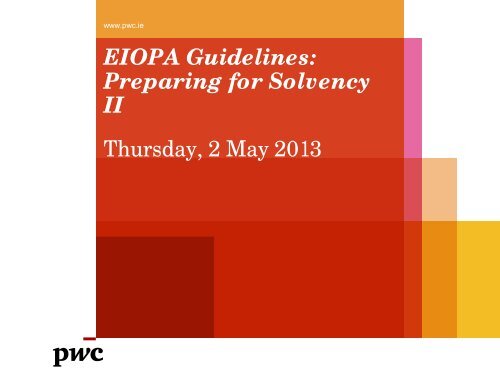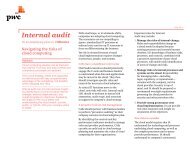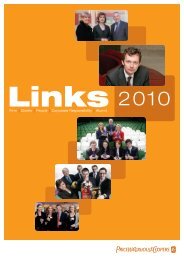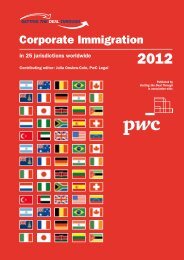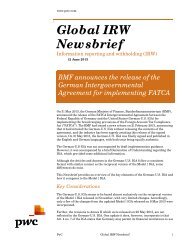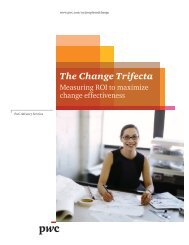EIOPA Guidelines: Preparing for Solvency II Thursday, 2 May ... - PwC
EIOPA Guidelines: Preparing for Solvency II Thursday, 2 May ... - PwC
EIOPA Guidelines: Preparing for Solvency II Thursday, 2 May ... - PwC
You also want an ePaper? Increase the reach of your titles
YUMPU automatically turns print PDFs into web optimized ePapers that Google loves.
www.pwc.ie<br />
<strong>EIOPA</strong> <strong>Guidelines</strong>:<br />
<strong>Preparing</strong> <strong>for</strong> <strong>Solvency</strong><br />
<strong>II</strong><br />
<strong>Thursday</strong>, 2 <strong>May</strong> 2013
Implementation approach<br />
Garvan O’Neill<br />
Head of Financial Services Regulatory Practice<br />
<strong>EIOPA</strong> <strong>Guidelines</strong>- <strong>Preparing</strong> <strong>for</strong> <strong>Solvency</strong> <strong>II</strong><br />
<strong>PwC</strong><br />
<strong>May</strong> 2013<br />
Slide 2
Why the interim measures...<br />
“The present EU supervisory regime is not sufficiently risk sensitive<br />
and is to be replaced by <strong>Solvency</strong> <strong>II</strong>. It is in the best interests of<br />
policyholders, insurers, and supervisors to build on the steps taken<br />
already to prepare <strong>for</strong> <strong>Solvency</strong> <strong>II</strong>. Without such preparation, there is<br />
a risk that momentum is lost and the benefits of the financial and<br />
human resources already devoted to the <strong>Solvency</strong> <strong>II</strong> project are<br />
dissipated.”<br />
<strong>EIOPA</strong> <strong>Guidelines</strong>- <strong>Preparing</strong> <strong>for</strong> <strong>Solvency</strong> <strong>II</strong><br />
<strong>PwC</strong><br />
<strong>EIOPA</strong> Cover Note <strong>for</strong> the Consultation on<br />
<strong>Guidelines</strong> on preparing <strong>for</strong> <strong>Solvency</strong> <strong>II</strong><br />
<strong>May</strong> 2013<br />
Slide 3
Where are we now...<br />
• Letter issued in October 2012 by the Chairman of <strong>EIOPA</strong>, Gabriel Bernardino, to the Omnibus <strong>II</strong><br />
tialogue parties re: <strong>Solvency</strong> <strong>II</strong> timelines. The letter raised <strong>EIOPA</strong>’s concerns with respect to “stagnant<br />
Omnibus <strong>II</strong> negotiations and their impact on the <strong>Solvency</strong> <strong>II</strong> project”<br />
• <strong>EIOPA</strong> Opinion of 20 December 2012 on interim measures regarding <strong>Solvency</strong> <strong>II</strong>, setting out<br />
proposed actions to be taken by National Competent Authorities<br />
• Cover Note and <strong>Guidelines</strong> <strong>for</strong> the preparation of <strong>Solvency</strong> <strong>II</strong> (public consultation):<br />
• Issued on 27 th March 2013 to support preparation by NCAs and the industry on key aspects of <strong>Solvency</strong> <strong>II</strong>:<br />
- System of Governance, including risk management (CP 13/008)<br />
- Forward looking assessment of undertaking’s own risk (based on ORSA principles) – (CP13/009)<br />
- Submission of in<strong>for</strong>mation to National Competent Authorities (CP 13/010)<br />
- Pre-application <strong>for</strong> Internal Models (CP 13/011)<br />
<strong>EIOPA</strong> <strong>Guidelines</strong>- <strong>Preparing</strong> <strong>for</strong> <strong>Solvency</strong> <strong>II</strong><br />
<strong>PwC</strong><br />
<strong>May</strong> 2013<br />
Slide 4
What are the timelines...<br />
2016 current best guess <strong>for</strong> full implementation<br />
However Interim Measures are the first real deliverable. Starting from 1 st<br />
January 2014. Time to start implementing!<br />
Level 1<br />
The Framework<br />
Directive<br />
Level 2<br />
Implementing<br />
Measures<br />
Interim Measures<br />
Level 3<br />
<strong>Guidelines</strong> and<br />
Binding Standards<br />
LTGA &<br />
ST*<br />
Dec 12–<br />
Apr 13?<br />
Issued by<br />
<strong>EIOPA</strong> <strong>for</strong><br />
consultation<br />
<strong>EIOPA</strong> <strong>Guidelines</strong>- <strong>Preparing</strong> <strong>for</strong> <strong>Solvency</strong> <strong>II</strong><br />
<strong>PwC</strong><br />
2013<br />
LTGA & ST<br />
Report –<br />
Q2/3 2013<br />
Published<br />
by <strong>EIOPA</strong><br />
Ongoing pre-consultations – Group<br />
supervision, Audit, etc.<br />
Omnibus <strong>II</strong><br />
Vote Q3/4<br />
2013<br />
Finalisation<br />
by EC<br />
Implemented<br />
by CBI<br />
2014<br />
Transposition into national law<br />
Consult? Adopt and publish<br />
Effective from 1 st Jan<br />
14 – Governance,<br />
ORSA, Internal Model<br />
Pre-approval<br />
Consult and publish<br />
2015 2016<br />
1st<br />
Reporting<br />
to CBI<br />
Further technical<br />
standards and<br />
guidance?<br />
Effective<br />
date of<br />
1 Jan 16?<br />
<strong>May</strong> 2013<br />
Slide 5
Where are we now...<br />
Overview of the Cover Note <strong>for</strong> the Consultation on <strong>Guidelines</strong> on preparing <strong>for</strong> <strong>Solvency</strong> <strong>II</strong><br />
Section 1<br />
Section 2<br />
Section 3<br />
Section 4<br />
Section 5<br />
• Purpose<br />
• Benefits of consistent preparation <strong>for</strong> <strong>Solvency</strong> <strong>II</strong><br />
• What is expected of National Competent Authorities (NCAs)?<br />
• Nature of the <strong>Guidelines</strong><br />
• Addressed to the NCAs<br />
• Outline of Compliance and Reporting requirements (compliance report, annual progress report)<br />
• Scope and Contents of the <strong>Guidelines</strong><br />
• System of Governance<br />
• Forward Looking assessment of the undertaking’s own risks<br />
• Submission of in<strong>for</strong>mation to NCAs<br />
• Pre-application of Internal Models<br />
• Approach<br />
• Principle of Proportionality; outline of ‘Phasing-in’ approach<br />
• Approach to small and medium-sized undertakings – the use of thresholds<br />
• Connection to pillar I <strong>Solvency</strong> <strong>II</strong> requirements<br />
• Timing and next steps<br />
• Consultation open until 19 th June 2013, final <strong>Guidelines</strong> to be issued in autumn 2013<br />
• <strong>Guidelines</strong> to apply from 1 st January 2014<br />
<strong>EIOPA</strong> <strong>Guidelines</strong>- <strong>Preparing</strong> <strong>for</strong> <strong>Solvency</strong> <strong>II</strong><br />
<strong>PwC</strong><br />
<strong>May</strong> 2013<br />
Slide 6
What do we have to look <strong>for</strong>ward to...<br />
• Principles based <strong>Guidelines</strong> issued to prepare <strong>for</strong> <strong>Solvency</strong> <strong>II</strong><br />
• NCAs to ensure that undertakings take steps towards implementing the <strong>Guidelines</strong><br />
• No supervisory action to be taken <strong>for</strong> failure to comply with <strong>Solvency</strong> <strong>II</strong> requirements<br />
• Compliance Report to be issued within 2 months following final issuance* of the <strong>Guidelines</strong><br />
• Compliance Report to detail measures taken at national level<br />
• Annual Progress Report to be issued by the NCAs by end February following each year of<br />
application of the <strong>Guidelines</strong> (1 st deadline: 28 th Feb 2015)<br />
_____________________________________________<br />
* The date on which <strong>Guidelines</strong> are published in each of the official EU languages<br />
<strong>EIOPA</strong> <strong>Guidelines</strong>- <strong>Preparing</strong> <strong>for</strong> <strong>Solvency</strong> <strong>II</strong><br />
<strong>PwC</strong><br />
<strong>May</strong> 2013<br />
Slide 7
What do we have to look <strong>for</strong>ward to...<br />
Use of thresholds during the preparatory phase<br />
• Applied to the following 2 aspects of the <strong>for</strong>ward looking solvency assessment:<br />
(1) assessment whether the undertaking would comply on a continuous basis with the <strong>Solvency</strong> <strong>II</strong> regulatory capital<br />
requirements and requirements regarding the calculation of technical provisions, and<br />
(2) assessment of deviations from the assumptions underlying the solvency capital requirement calculation<br />
• Applied to the quantitative reporting requirements<br />
• Proposed thresholds:<br />
(i) Min. coverage by NCA of 80% of the market share<br />
(ii) Min. coverage by NCA of 50% of the market share<br />
(iii) €12 billion of total assets, or the equivalent amount in<br />
another national currency<br />
<strong>EIOPA</strong> <strong>Guidelines</strong>- <strong>Preparing</strong> <strong>for</strong> <strong>Solvency</strong> <strong>II</strong><br />
<strong>PwC</strong><br />
Solo annual set of<br />
quantitative reporting items<br />
Solo quarterly set of<br />
quantitative in<strong>for</strong>mation<br />
Groups annual and quarterly set of<br />
quantitative in<strong>for</strong>mation<br />
<strong>May</strong> 2013<br />
Slide 8
How the CBI will react...<br />
The CBI position pre-issuance:<br />
“The Central Bank has (...) decided not to bring <strong>for</strong>ward proposals <strong>for</strong> early <strong>Solvency</strong> <strong>II</strong><br />
implementation independently of action by <strong>EIOPA</strong> or other regulators.<br />
The Central Bank of Ireland is working closely with <strong>EIOPA</strong> to achieve a consistent and convergent<br />
approach across the EU to <strong>Solvency</strong> <strong>II</strong> implementation. This may entail early adoption by 2014 of<br />
some elements of <strong>Solvency</strong> <strong>II</strong>, primarily, but not limited to, Pillar 2.”<br />
The CBI intend to comply but emphasize that:<br />
• Proportionality will be applied (together with the application of thresholds),<br />
• These are <strong>Guidelines</strong> to assist in progression towards <strong>Solvency</strong> <strong>II</strong>, and<br />
• The explanatory texts are not part of the <strong>Guidelines</strong>.<br />
<strong>EIOPA</strong> <strong>Guidelines</strong>- <strong>Preparing</strong> <strong>for</strong> <strong>Solvency</strong> <strong>II</strong><br />
<strong>PwC</strong><br />
Central Bank of Ireland,<br />
December 2012<br />
<strong>May</strong> 2013<br />
Slide 9
What next <strong>for</strong> you...<br />
Colin Manley<br />
Tony O’Riordan<br />
<strong>EIOPA</strong> <strong>Guidelines</strong>- <strong>Preparing</strong> <strong>for</strong> <strong>Solvency</strong> <strong>II</strong><br />
<strong>PwC</strong><br />
• Systems of governance<br />
• Reporting to regulators<br />
David McGee • Data challenges<br />
• Forward looking assessment of the insurer’s own risk<br />
• Pre-application <strong>for</strong> internal models<br />
Garvan O’Neill • Conclusions and CRO Network<br />
Drinks reception<br />
<strong>May</strong> 2013<br />
Slide 10
System of governance<br />
Colin Manley<br />
Principal Consultant, Non Life Actuarial Practice<br />
<strong>EIOPA</strong> <strong>Guidelines</strong>- <strong>Preparing</strong> <strong>for</strong> <strong>Solvency</strong> <strong>II</strong><br />
<strong>PwC</strong><br />
<strong>May</strong> 2013<br />
Slide 11
<strong>EIOPA</strong> guidelines on system of governance<br />
Agenda<br />
1. What the <strong>Guidelines</strong> require<br />
2. Differences to the Corporate Governance Code<br />
3. <strong>PwC</strong> view on what you need to do<br />
4. <strong>PwC</strong> view on challenges you may face<br />
<strong>EIOPA</strong> <strong>Guidelines</strong>- <strong>Preparing</strong> <strong>for</strong> <strong>Solvency</strong> <strong>II</strong><br />
<strong>PwC</strong><br />
<strong>May</strong> 2013<br />
Slide 12
<strong>EIOPA</strong> guidelines on system of governance<br />
What do the guidelines require?<br />
Undertakings to take appropriate steps to:<br />
• Build an effective system of governance according to the <strong>Solvency</strong> <strong>II</strong> Directive<br />
• Build an effective risk management system<br />
• Evidence the system of governance <strong>for</strong> the CBI<br />
CBI to report progress to <strong>EIOPA</strong> following each relevant year – first at end February 2015<br />
<strong>EIOPA</strong> <strong>Guidelines</strong>- <strong>Preparing</strong> <strong>for</strong> <strong>Solvency</strong> <strong>II</strong><br />
<strong>PwC</strong><br />
<strong>May</strong> 2013<br />
Slide 13
<strong>EIOPA</strong> guidelines on system of governance<br />
What do the guidelines require?<br />
1<br />
2<br />
3<br />
4<br />
5<br />
6<br />
7<br />
8<br />
9<br />
10<br />
• General Governance<br />
Requirements<br />
•Fit and Proper<br />
Requirements<br />
•Risk Management<br />
•The “Prudent Person”<br />
Principle<br />
•Own Fund Requirements<br />
•Internal Controls<br />
•Internal Audit Function<br />
•Actuarial Function<br />
•Outsourcing<br />
•Group Governance Specific<br />
Requirements<br />
<strong>EIOPA</strong> <strong>Guidelines</strong>- <strong>Preparing</strong> <strong>for</strong> <strong>Solvency</strong> <strong>II</strong><br />
<strong>PwC</strong><br />
• 57 <strong>Guidelines</strong><br />
• <strong>Guidelines</strong> develop on Articles 40-49 of the S<strong>II</strong><br />
Directive<br />
• New aspects - Own Funds (Article 93) and Prudent<br />
Person Principle (Article 132)<br />
• Consistent with:<br />
Summary of <strong>Guidelines</strong><br />
• prior consultations<br />
• Corporate Governance Code (2010)<br />
• Insurance Core Principles published by IAIS<br />
<strong>May</strong> 2013<br />
Slide 14
<strong>EIOPA</strong> guidelines on system of governance<br />
Differences from the code<br />
• Code more focused at Board level<br />
• Code prescribes size of Boards, numbers of directorships, minimum<br />
number of meetings – the <strong>Guidelines</strong> do not<br />
• <strong>Guidelines</strong> are more prescriptive:<br />
- Key Functions<br />
- Detail of Risk Policies<br />
- Focus below Board level<br />
• ‘New’ governance aspects introduced<br />
<strong>EIOPA</strong> <strong>Guidelines</strong>- <strong>Preparing</strong> <strong>for</strong> <strong>Solvency</strong> <strong>II</strong><br />
<strong>PwC</strong><br />
<strong>May</strong> 2013<br />
Slide 15
<strong>EIOPA</strong> guidelines on system of governance<br />
New in guidelines<br />
Prudent<br />
Person<br />
Principle<br />
Own Funds<br />
Group<br />
Governance<br />
<strong>EIOPA</strong> <strong>Guidelines</strong>- <strong>Preparing</strong> <strong>for</strong> <strong>Solvency</strong> <strong>II</strong><br />
<strong>PwC</strong><br />
• Develop set of key indicators (concentration metrics, sector<br />
allocations, ratings / security metrics) <strong>for</strong> investment management<br />
purposes<br />
• Particular duty of care <strong>for</strong> investments ‘outside the norm’ e.g.<br />
derivatives, private equity etc.<br />
• Capital Management Policy<br />
• Medium-term Capital Plan (including Dividend Policy)<br />
• Specific governance and risk management requirements at Group<br />
level<br />
<strong>May</strong> 2013<br />
Slide 16
<strong>EIOPA</strong> guidelines on system of governance<br />
Key actions and challenges<br />
Key Functions<br />
1. Risk Management<br />
(and System)<br />
2. Actuarial Function<br />
3. Internal Audit<br />
4. Compliance<br />
Outsourcing<br />
<strong>EIOPA</strong> <strong>Guidelines</strong>- <strong>Preparing</strong> <strong>for</strong> <strong>Solvency</strong> <strong>II</strong><br />
<strong>PwC</strong><br />
Forward Looking<br />
Risk Assessment<br />
‘ORSA’<br />
Reporting to Regulators<br />
Proportionality<br />
<strong>May</strong> 2013<br />
Slide 17
<strong>EIOPA</strong> guidelines on system of governance<br />
Key functions: risk management<br />
Actions<br />
Challenges<br />
<strong>EIOPA</strong> <strong>Guidelines</strong>- <strong>Preparing</strong> <strong>for</strong> <strong>Solvency</strong> <strong>II</strong><br />
<strong>PwC</strong><br />
• Establish a Risk Management Function<br />
• Develop (Update) Risk Management Policies<br />
• Implement a Risk Management System<br />
− to include Internal Model management<br />
• Division of responsibility<br />
• Independence / Objectivity<br />
• Dual Roles<br />
• Availability of talent / broader skill sets<br />
• Granularity and prescription of Risk Policy detail<br />
• Demonstrating compliance<br />
• Appropriateness of MI<br />
• Managing the Internal Model process<br />
<strong>May</strong> 2013<br />
Slide 18
<strong>EIOPA</strong> guidelines on system of governance<br />
Key functions: actuarial function<br />
Actions<br />
Challenges<br />
<strong>EIOPA</strong> <strong>Guidelines</strong>- <strong>Preparing</strong> <strong>for</strong> <strong>Solvency</strong> <strong>II</strong><br />
<strong>PwC</strong><br />
• Decide on mechanism <strong>for</strong> establishment of an Actuarial Function (“AF”)<br />
– Internal, External, Cross department<br />
• Allocate responsibility <strong>for</strong> each required task<br />
• Decide on nature and extent of reporting from AF<br />
– Technical Provisions, Data Quality, Experience Testing<br />
• Not previously a <strong>for</strong>mal requirement<br />
• AF not necessarily an Actuary<br />
• Dual regulation period: <strong>Solvency</strong> I and ‘quasi-<strong>Solvency</strong> <strong>II</strong>’<br />
− 2 sets of technical provisions?<br />
• Does AF apply <strong>for</strong> companies below threshold?<br />
• Oversight role? Validated versus calculate?<br />
• Outsourcing AF: Fit & Proper<br />
• Additional AF Tasks: conflicts of interest e.g. pricing<br />
• Reporting lines <strong>for</strong> the AF: CFO? CRO? CEO?<br />
<strong>May</strong> 2013<br />
Slide 19
<strong>EIOPA</strong> guidelines on system of governance<br />
Key functions: internal audit and internal controls<br />
Actions<br />
Challenges<br />
<strong>EIOPA</strong> <strong>Guidelines</strong>- <strong>Preparing</strong> <strong>for</strong> <strong>Solvency</strong> <strong>II</strong><br />
<strong>PwC</strong><br />
• Likely no substantive actions<br />
• Internal Audit and Compliance functions already in place<br />
• New skill sets required of Internal Audit<br />
− Internal Model<br />
− Standard Model<br />
− Risk Management System<br />
− Data quality assurance<br />
• Resourcing the Internal Audit function<br />
• Reliance on Group <strong>for</strong> technical skills<br />
<strong>May</strong> 2013<br />
Slide 20
<strong>EIOPA</strong> guidelines on system of governance<br />
Forward looking assessment (‘ORSA’)<br />
Actions<br />
Challenges<br />
<strong>EIOPA</strong> <strong>Guidelines</strong>- <strong>Preparing</strong> <strong>for</strong> <strong>Solvency</strong> <strong>II</strong><br />
<strong>PwC</strong><br />
• Develop ORSA policy<br />
• Board steer how the ORSA process is conducted<br />
• Board to challenge the ORSA<br />
• Board required to play an active part<br />
• Board skill set to increase<br />
• Documentation and record keeping of ORSA process<br />
<strong>May</strong> 2013<br />
Slide 21
<strong>EIOPA</strong> guidelines on system of governance<br />
Outsourcing<br />
Actions<br />
Challenges<br />
<strong>EIOPA</strong> <strong>Guidelines</strong>- <strong>Preparing</strong> <strong>for</strong> <strong>Solvency</strong> <strong>II</strong><br />
<strong>PwC</strong><br />
• Review current arrangements<br />
− check F&P requirements<br />
• Decide what is going to be outsourced<br />
• <strong>Guidelines</strong> extend beyond current CBI F&P requirements<br />
− no specific exclusion relating to other regulated financial<br />
service provider<br />
• Governance of outsourced activities<br />
• CBI challenges?<br />
<strong>May</strong> 2013<br />
Slide 22
<strong>EIOPA</strong> guidelines on system of governance<br />
Other<br />
Reporting to<br />
Regulators<br />
<strong>EIOPA</strong> <strong>Guidelines</strong>- <strong>Preparing</strong> <strong>for</strong> <strong>Solvency</strong> <strong>II</strong><br />
<strong>PwC</strong><br />
• The <strong>Guidelines</strong> require undertakings above the threshold to report<br />
‘interim’ in<strong>for</strong>mation to the regulators<br />
• What will be the governance structure around this?<br />
• Qualitative reporting also requires narrative in<strong>for</strong>mation on adherence<br />
to general governance requirements<br />
Proportionality • Applies to every element of System of Governance<br />
• <strong>Solvency</strong> <strong>II</strong> not prescriptive around this but also little guidance<br />
• Consistency of application<br />
<strong>May</strong> 2013<br />
Slide 23
Reporting to regulators<br />
<strong>EIOPA</strong> <strong>Guidelines</strong>- <strong>Preparing</strong> <strong>for</strong> <strong>Solvency</strong> <strong>II</strong><br />
<strong>PwC</strong><br />
<strong>May</strong> 2013<br />
Slide 24
<strong>EIOPA</strong> guidelines on reporting to regulators<br />
Submission of in<strong>for</strong>mation to regulator<br />
What?<br />
• Quantitative & qualitative in<strong>for</strong>mation required is a subset of the full package published in July 2012<br />
(approx 40% of templates)<br />
• Still a significant amount of in<strong>for</strong>mation<br />
• Internal Model pre-application companies should submit both model and standard <strong>for</strong>mula<br />
calculations<br />
• Assumption that Pillar 1 requirements agreed and known by 2015<br />
When?<br />
• Annual: Financial year end on or after 31 December 2014 – no later than 20 weeks after year end<br />
• Quarterly: Quarter ending 30 September 2015 – no later than 8 weeks after quarter end<br />
Who?<br />
• Annual 80%, Quarterly 50%, guidelines applied in a manner which is proportionate<br />
<strong>EIOPA</strong> <strong>Guidelines</strong>- <strong>Preparing</strong> <strong>for</strong> <strong>Solvency</strong> <strong>II</strong><br />
<strong>PwC</strong><br />
<strong>May</strong> 2013<br />
Slide 25
<strong>EIOPA</strong> guidelines on reporting to regulators<br />
Submission of in<strong>for</strong>mation to regulator<br />
Decision<br />
in the<br />
balance<br />
<strong>EIOPA</strong> <strong>Guidelines</strong>- <strong>Preparing</strong> <strong>for</strong> <strong>Solvency</strong> <strong>II</strong><br />
<strong>PwC</strong><br />
Wait and See:<br />
<strong>Solvency</strong> <strong>II</strong> timetable has slipped a lot so far, it<br />
may do so again<br />
Why invest in hitting a moving target<br />
There may be 2 nd mover advantages<br />
Begin preparations:<br />
95%+ of the requirements known<br />
Substantial lead-in time will be needed to prepare<br />
Much is useful info and should sensibly be used<br />
Fulfil ECB needs<br />
Regulators - increasing focus on risk<br />
analytics<br />
<strong>May</strong> 2013<br />
Slide 26
<strong>EIOPA</strong> guidelines on system of governance<br />
<strong>PwC</strong> experience<br />
An automated solution is required – meet<br />
deadlines, cope with granularity, reduce<br />
administrative burden, more robust quality<br />
<strong>EIOPA</strong> <strong>Guidelines</strong>- <strong>Preparing</strong> <strong>for</strong> <strong>Solvency</strong> <strong>II</strong><br />
<strong>PwC</strong><br />
It is a large development – can easily be 9-12<br />
month project (assuming data already in place)<br />
It is a cross functional project – Actuarial,<br />
Finance and IT<br />
<strong>May</strong> 2013<br />
Slide 27
Forward looking assessment of<br />
undertaking’s own risks (on ORSA<br />
principles)<br />
Tony O’Riordan<br />
Head of Life Actuarial Practice<br />
<strong>EIOPA</strong> <strong>Guidelines</strong>- <strong>Preparing</strong> <strong>for</strong> <strong>Solvency</strong> <strong>II</strong><br />
<strong>PwC</strong><br />
<strong>May</strong> 2013<br />
Slide 28
Principles<br />
CBI to ensure “a <strong>for</strong>ward looking view on the risks to which they are exposed similar t0<br />
what they will have to do once <strong>Solvency</strong> <strong>II</strong> will apply”.<br />
“...this assessment can be undertaken irrespective of what regulatory quantitative<br />
requirements are applicable ... per<strong>for</strong>m an assessment of ... overall solvency needs as of<br />
2014”<br />
“assessment of continuous compliance with regulatory capital requirements ....<br />
assessment of significance of deviation of risk profile...from.. .SCR according to...<strong>Solvency</strong><br />
<strong>II</strong> ... can only be per<strong>for</strong>med on the basis as if the undertaking would need to comply with<br />
these requirements”<br />
“...undertaking should decide <strong>for</strong> itself how to per<strong>for</strong>m this assessment...”<br />
Boards “aware of all material risks”, “active role in <strong>for</strong>ward looking assessment ...by<br />
directing and challenging its per<strong>for</strong>mance”<br />
“...high level of consistency in processes across the group...”<br />
“Undertakings applying <strong>for</strong> the approval of an internal model are expected to use the<br />
model...”<br />
<strong>EIOPA</strong> <strong>Guidelines</strong>- <strong>Preparing</strong> <strong>for</strong> <strong>Solvency</strong> <strong>II</strong><br />
<strong>PwC</strong><br />
<strong>May</strong> 2013<br />
Slide 29
Structure and overview<br />
Section 1<br />
Section 2<br />
Section 3<br />
Section 4<br />
• Introduction<br />
• Implementation Date, Thresholds, Principles<br />
• General Considerations<br />
• Proportionality, Board Approval,<br />
Documentation of Policy, Reports<br />
• Forward looking assessment of own risks<br />
• Assessment of overall solvency needs, <strong>for</strong>ward<br />
looking, regulatory capital, technical<br />
provisions, deviations from SCR, used in<br />
decision making, frequency<br />
• Group considerations<br />
• Group level requirements in relation to the<br />
above, internal models, non-EEA business<br />
<strong>EIOPA</strong> <strong>Guidelines</strong>- <strong>Preparing</strong> <strong>for</strong> <strong>Solvency</strong> <strong>II</strong><br />
<strong>PwC</strong><br />
Summary<br />
• <strong>Guidelines</strong> develop on Article<br />
45 of the S<strong>II</strong> Directive<br />
• <strong>Guidelines</strong> almost identical to<br />
consultation document issued<br />
in July 2012 (CP08)<br />
• Aligned with Insurance Core<br />
Principle 16 published by IAIS<br />
in 2008<br />
<strong>May</strong> 2013<br />
Slide 30
<strong>EIOPA</strong> <strong>Guidelines</strong>- <strong>Preparing</strong> <strong>for</strong> <strong>Solvency</strong> <strong>II</strong><br />
<strong>PwC</strong><br />
Nothing New?<br />
Nothing to<br />
Worry About?<br />
<strong>May</strong> 2013<br />
Slide 31
Outline of provisions<br />
General<br />
considerations<br />
<strong>EIOPA</strong> <strong>Guidelines</strong>- <strong>Preparing</strong> <strong>for</strong> <strong>Solvency</strong> <strong>II</strong><br />
<strong>PwC</strong><br />
•Build process and qualitative<br />
in<strong>for</strong>mation<br />
•CBI progress reports to <strong>EIOPA</strong><br />
•80% and Group requirement <strong>for</strong><br />
continuous S<strong>II</strong> compliance<br />
assessment<br />
•“Plan B” requirement <strong>for</strong> IMAP<br />
companies<br />
•Assessment of significance of<br />
deviation <strong>for</strong> non-IMAP companies<br />
•Own, tailored processes<br />
(proportional)<br />
•Board takes active part<br />
<strong>May</strong> 2013<br />
Slide 32
Outline of provisions<br />
General<br />
considerations<br />
<strong>EIOPA</strong> <strong>Guidelines</strong>- <strong>Preparing</strong> <strong>for</strong> <strong>Solvency</strong> <strong>II</strong><br />
<strong>PwC</strong><br />
•Board to approve policy<br />
•Each FLA to be “appropriately”<br />
evidenced and documented<br />
- Policy<br />
- Record<br />
- Internal report<br />
- Supervisory report<br />
•Results and conclusions to be<br />
communicated internally<br />
•Submit “supervisory report”<br />
within 2 weeks of “concluding the<br />
assessments”<br />
<strong>May</strong> 2013<br />
Slide 33
Outline of provisions<br />
Assessment of<br />
solvency and<br />
compliance<br />
<strong>EIOPA</strong> <strong>Guidelines</strong>- <strong>Preparing</strong> <strong>for</strong> <strong>Solvency</strong> <strong>II</strong><br />
<strong>PwC</strong><br />
•Requirement to explain benefits<br />
and quantify impact of<br />
methodology other than S<strong>II</strong><br />
•Quantitative solvency<br />
requirements, qualitative risk<br />
description with stress tests<br />
•Medium to long term perspective<br />
•Assess continuous compliance<br />
allowing <strong>for</strong> changes in risk<br />
profile<br />
•Actuarial function to provide<br />
input<br />
<strong>May</strong> 2013<br />
Slide 34
General provisions <strong>for</strong> preparatory guidelines<br />
Assessment of<br />
solvency and<br />
compliance<br />
<strong>EIOPA</strong> <strong>Guidelines</strong>- <strong>Preparing</strong> <strong>for</strong> <strong>Solvency</strong> <strong>II</strong><br />
<strong>PwC</strong><br />
•Assess deviation of risk profile<br />
from assumptions underlying SCR<br />
calculation (qualitative initially)<br />
•Use test – consider FLA in<br />
- capital management<br />
- business planning<br />
- product development<br />
•FLA at least annual<br />
<strong>May</strong> 2013<br />
Slide 35
General provisions <strong>for</strong> preparatory guidelines<br />
“Group” guidelines<br />
<strong>EIOPA</strong> <strong>Guidelines</strong>- <strong>Preparing</strong> <strong>for</strong> <strong>Solvency</strong> <strong>II</strong><br />
<strong>PwC</strong><br />
•Reflect group structure and risk<br />
profile. All entities in scope.<br />
•Single FLA? Subsidiary entity<br />
and Board explanation.<br />
•Allow <strong>for</strong> group specific risks and<br />
strategies<br />
•Transferability, fungibility of<br />
capital<br />
•Report on entities not using<br />
internal model<br />
•Consistent treatment of third<br />
countries<br />
<strong>May</strong> 2013<br />
Slide 36
Issues emerging which may invite comment<br />
• Comply with <strong>Solvency</strong> <strong>II</strong><br />
requirements though not<br />
finalised<br />
• How to reflect <strong>Solvency</strong> I?<br />
• Fixed commencement<br />
irrespective of S<strong>II</strong> start<br />
• “as of 2014”?<br />
• Definition of Group<br />
• Consistency across Group<br />
• 4 documents<br />
<strong>EIOPA</strong> <strong>Guidelines</strong>- <strong>Preparing</strong> <strong>for</strong> <strong>Solvency</strong> <strong>II</strong><br />
<strong>PwC</strong><br />
• Use internal model but “Plan B”<br />
• Explanation of benefits of non-<br />
S<strong>II</strong> methods<br />
• 2 week submission requirement<br />
• What is the role of the actuarial<br />
function?<br />
• Requirement to use internal<br />
model if in IMAP<br />
• Will NCAs comply? What if<br />
different approaches?<br />
<strong>May</strong> 2013<br />
Slide 37
Key considerations and challenges<br />
What areas require your action or consideration?<br />
<strong>Solvency</strong> <strong>II</strong> Numbers<br />
Point in time and<br />
continuous<br />
Documenting the<br />
Process and Policy<br />
and Producing the<br />
ORSA Reports<br />
<strong>EIOPA</strong> <strong>Guidelines</strong>- <strong>Preparing</strong> <strong>for</strong> <strong>Solvency</strong> <strong>II</strong><br />
<strong>PwC</strong><br />
Projecting<br />
Capital<br />
Internal Model Approval<br />
(where there is one)<br />
The Use Test<br />
Largest<br />
80%<br />
All<br />
companies<br />
<strong>May</strong> 2013<br />
Slide 38
The use test – embedding risk management in<br />
business strategy and decisions<br />
Risk Identification and Assessment<br />
Risk identification<br />
Qualitative assessments<br />
Controls assessment<br />
Risk ranking and classification<br />
Risk profile<br />
Risk management policy<br />
<strong>EIOPA</strong> <strong>Guidelines</strong>- <strong>Preparing</strong> <strong>for</strong> <strong>Solvency</strong> <strong>II</strong><br />
<strong>PwC</strong><br />
Business objectives<br />
Risk strategy<br />
Strategy options<br />
valuations<br />
Capital strategy<br />
Capital plan<br />
Financial plan<br />
Business Strategy<br />
<strong>Solvency</strong> Assessment and Management<br />
Economic balance<br />
sheet<br />
Technical provisions<br />
Risk parameters and<br />
assumptions<br />
Own fund<br />
classification and<br />
assessment<br />
Strategic asset<br />
allocation<br />
Reinsurance / hedge<br />
Management<br />
actions<br />
Projection horizons<br />
Actual vs. Plan<br />
Stress / scenario testing<br />
Capital fungibility<br />
Internal capital<br />
requirement<br />
Regulatory capital<br />
requirement<br />
Reconciliation<br />
External Environment<br />
Business context<br />
Emerging risks<br />
Long-term risks<br />
Macroeconomic environment<br />
Regulatory framework<br />
Legal framework<br />
Social trends<br />
Decision Making<br />
Regular monitoring of risk profile<br />
<strong>Solvency</strong> monitoring and management<br />
Risk appetite / tolerance<br />
Frequency of assessment<br />
Support <strong>for</strong> strategic decisions<br />
Evidence of risk governance processes<br />
Disclosure<br />
<strong>May</strong> 2013<br />
Slide 39
Reinsurers and<br />
Non-Life insurers<br />
may need to<br />
enhance new<br />
models<br />
“Top 80%” Need to<br />
cope with <strong>Solvency</strong><br />
<strong>II</strong> numbers<br />
<strong>EIOPA</strong> <strong>Guidelines</strong>- <strong>Preparing</strong> <strong>for</strong> <strong>Solvency</strong> <strong>II</strong><br />
<strong>PwC</strong><br />
Projecting capital<br />
• Life insurers will be familiar with projecting<br />
capital <strong>for</strong> triennial Financial Condition Reports<br />
(FCRs)<br />
• Annual reporting: Time and cost issues<br />
• Reinsurers and Non-life insurers have had no<br />
previous regulatory requirement to project capital<br />
• Models will need to be built to produce<br />
numbers<br />
• Need to determine appropriate time horizon <strong>for</strong><br />
projections<br />
• <strong>Guidelines</strong> refer to “business planning period”<br />
• <strong>Solvency</strong> <strong>II</strong> numbers <strong>for</strong> “top 80% of market”<br />
<strong>May</strong> 2013<br />
Slide 40
Within the ORSA<br />
<strong>Guidelines</strong> this is<br />
the No.1<br />
Implementation<br />
Challenge <strong>for</strong><br />
companies within<br />
80% scope<br />
<strong>EIOPA</strong> <strong>Guidelines</strong>- <strong>Preparing</strong> <strong>for</strong> <strong>Solvency</strong> <strong>II</strong><br />
<strong>PwC</strong><br />
<strong>Solvency</strong> <strong>II</strong><br />
For “top 80% of Market”<br />
• Capital and Reserve numbers within ORSA are to<br />
be calculated on a <strong>Solvency</strong> <strong>II</strong> basis<br />
• Best estimate liabilities<br />
• <strong>Solvency</strong> Capital Requirements<br />
• Assess deviations of own risk profile from<br />
assumptions underlying SCR calculations<br />
• Complexity in projecting economic capital<br />
numbers is not to be under-estimated<br />
• Projections within projections<br />
• Data and IT processing power<br />
• Theoretically no regulatory intervention if S<strong>II</strong><br />
numbers breached but this raises difficult issue<br />
<strong>for</strong> CBI<br />
<strong>May</strong> 2013<br />
Slide 41
Key considerations and challenges<br />
What areas require your action or consideration?<br />
<strong>Solvency</strong> <strong>II</strong> Numbers<br />
Documenting the<br />
Process and Policy<br />
and Producing the<br />
ORSA Reports<br />
<strong>EIOPA</strong> <strong>Guidelines</strong>- <strong>Preparing</strong> <strong>for</strong> <strong>Solvency</strong> <strong>II</strong><br />
<strong>PwC</strong><br />
Projecting<br />
Capital<br />
Internal Model Approval<br />
The Use Test<br />
Largest<br />
80%<br />
All<br />
companies<br />
<strong>May</strong> 2013<br />
Slide 42
Pre-application <strong>for</strong> internal models<br />
<strong>EIOPA</strong> <strong>Guidelines</strong>- <strong>Preparing</strong> <strong>for</strong> <strong>Solvency</strong> <strong>II</strong><br />
<strong>PwC</strong><br />
<strong>May</strong> 2013<br />
Slide 43
<strong>EIOPA</strong> guidelines on pre-application of internal<br />
models<br />
Overview<br />
Summary of guidelines<br />
1<br />
2<br />
3<br />
4<br />
5<br />
6<br />
7<br />
8<br />
9<br />
•General guidelines<br />
•Model changes<br />
•Use test<br />
•Assumption setting and<br />
expert judgement<br />
•Methodological consistency<br />
•Probability distribution<br />
<strong>for</strong>ecast<br />
•Calibration - approximations<br />
•Profit and loss attribution<br />
•Validation<br />
10 •Documentation<br />
11<br />
12<br />
• External models and data<br />
• Functioning of colleges<br />
<strong>EIOPA</strong> <strong>Guidelines</strong>- <strong>Preparing</strong> <strong>for</strong> <strong>Solvency</strong> <strong>II</strong><br />
<strong>PwC</strong><br />
• 72 <strong>Guidelines</strong> in total covering various aspects of<br />
the Pre-Application of Internal Models <strong>for</strong><br />
approval<br />
• Many supervisors have established preapplication<br />
processes to help insurers through<br />
the journey to submission of a final internal<br />
model application<br />
• <strong>EIOPA</strong>’s draft guidelines aim to <strong>for</strong>malise this<br />
process in response to pressure from the<br />
industry and to increase convergence of<br />
supervisory practices across the EU<br />
• The draft guidelines cover a number of areas<br />
which national regulators should review<br />
• No game changers <strong>for</strong> IMAP – bar remains high<br />
<strong>May</strong> 2013<br />
Slide 44
CBI process<br />
assessed by<br />
<strong>EIOPA</strong> to be<br />
well developed<br />
relative to<br />
others<br />
<strong>EIOPA</strong> <strong>Guidelines</strong>- <strong>Preparing</strong> <strong>for</strong> <strong>Solvency</strong> <strong>II</strong><br />
<strong>PwC</strong><br />
Key new requirements and<br />
challenges<br />
New requirements<br />
• “Validation report” setting out results and<br />
conclusions drawn from validation process<br />
• “User manual” <strong>for</strong> operation of model<br />
• For group models, an agreed “work plan”<br />
between group and local supervisors<br />
Ongoing challenges<br />
• Considerable interpretation still required, eg<br />
documentation, use test, understanding of<br />
Board, model changes<br />
• Proportionality?<br />
• Regulator consistency<br />
<strong>May</strong> 2013<br />
Slide 45
Data challenges<br />
David McGee<br />
Partner, Advisory Consulting<br />
<strong>EIOPA</strong> <strong>Guidelines</strong>- <strong>Preparing</strong> <strong>for</strong> <strong>Solvency</strong> <strong>II</strong><br />
<strong>PwC</strong><br />
<strong>May</strong> 2013<br />
Slide 46
Impact of <strong>Solvency</strong> <strong>II</strong> on the insurance industry<br />
Reporting requirements Client issues<br />
Accuracy<br />
Completeness<br />
Timeliness<br />
Availability<br />
Traceability<br />
Scalability<br />
<strong>EIOPA</strong> <strong>Guidelines</strong>- <strong>Preparing</strong> <strong>for</strong> <strong>Solvency</strong> <strong>II</strong><br />
<strong>PwC</strong><br />
“Manual steps in my data collection and reporting process result in<br />
erroneous output.”<br />
“How to consolidate data from a variety of source systems, <strong>for</strong>mats and<br />
definitions into a single report.”<br />
“With the time consumed in collecting data and consolidating reports from<br />
solo entities, meeting reporting deadlines is cumbersome.”<br />
“Leveraging data collected as part of <strong>Solvency</strong> <strong>II</strong> requirements beyond mere<br />
disclosure, proves to be a challenge.”<br />
“Traceability of approvals, manual adjustments and corrections is lost<br />
throughout the reporting process.”<br />
“Keeping track of data elements in QRT reports and tracing them back to<br />
source systems is challenging.”<br />
“The volume of data required and the number of source systems, means<br />
that I can no longer do this manually.”<br />
How to leverage technology to meet <strong>Solvency</strong> <strong>II</strong> reporting<br />
requirements is going to be key to success<br />
<strong>May</strong> 2013<br />
Slide 47
MI – common industry challenges<br />
What is going on with the data?<br />
Slow<br />
Strategically<br />
misaligned<br />
<strong>EIOPA</strong> <strong>Guidelines</strong>- <strong>Preparing</strong> <strong>for</strong> <strong>Solvency</strong> <strong>II</strong><br />
<strong>PwC</strong><br />
Insufficient<br />
Not effective<br />
Not<br />
insightful<br />
Multiple<br />
versions<br />
Too detailed<br />
<strong>May</strong> 2013<br />
Slide 48
MI – common industry challenges<br />
Data is complex<br />
You may not<br />
believe what you<br />
see<br />
81 %<br />
don’t have quality<br />
source data<br />
<strong>EIOPA</strong> <strong>Guidelines</strong>- <strong>Preparing</strong> <strong>for</strong> <strong>Solvency</strong> <strong>II</strong><br />
<strong>PwC</strong><br />
You may be basing<br />
decisions on<br />
intuition more<br />
often than ideal<br />
40 %<br />
of companies have<br />
not implemented<br />
the KPIs they<br />
need<br />
Source – <strong>PwC</strong>’s European Corporate Per<strong>for</strong>mance Management (“CPM”) survey<br />
You may not be able<br />
to give transparency<br />
to key stakeholders<br />
73:27<br />
Time spent<br />
producing/ Time<br />
spent analysing<br />
ratio. Desired 40:60<br />
You may not be able<br />
to demonstrate that<br />
you are in control<br />
74 %<br />
of companies think<br />
scenario analysis is<br />
important, only<br />
26% do it regularly<br />
<strong>May</strong> 2013<br />
Slide 49
Finance today<br />
Current: Siloed data<br />
Embedded<br />
Business<br />
Partners<br />
BU A<br />
BU B<br />
BU C<br />
Business<br />
Partnering , MI,<br />
Forecasting<br />
Group finance,<br />
Investor<br />
Relations, M&A<br />
Future: Integrated Data<br />
Business<br />
Partnering , MI,<br />
Forecasting<br />
Group finance<br />
Reporting and<br />
controls<br />
<strong>EIOPA</strong> <strong>Guidelines</strong>- <strong>Preparing</strong> <strong>for</strong> <strong>Solvency</strong> <strong>II</strong><br />
<strong>PwC</strong><br />
CFO<br />
Back office,<br />
transactions,<br />
Valuation /<br />
Reserving<br />
Chief<br />
Actuary<br />
ALM<br />
Capital<br />
Management<br />
Oversight,<br />
Policy<br />
CRO<br />
Risk Reporting<br />
and Control<br />
Actuarial, Data, Assumptions, Systems,<br />
Back office, transactions, Risk Data, Systems, Controls<br />
Controls, Shared Services<br />
CFO<br />
Back office,<br />
transactions,<br />
shared services<br />
Valuation /<br />
Reserving<br />
Chief<br />
Actuary<br />
ALM<br />
Capital<br />
Management<br />
Common Data, Assumptions, Systems, Controls, Shared Services<br />
CRO<br />
Oversight,<br />
Policy<br />
Risk<br />
Committees<br />
Risk<br />
Committees<br />
Investor Relations<br />
Finance and<br />
Risk Business Partners<br />
Risk Escalation<br />
in the business<br />
Capital Strategy, Allocation<br />
BU A<br />
BU B<br />
BU C<br />
BU A<br />
BU B<br />
BU C<br />
Integrated Financial and Risk<br />
Reporting and Controls<br />
Change Function<br />
<strong>May</strong> 2013<br />
Slide 50
Lessons learned<br />
Implementing <strong>Solvency</strong> <strong>II</strong> reporting solutions should be considered a business driven initiative, as<br />
opposed to technology driven. Data quality should be addressed throughout the implementation<br />
initiative.<br />
Data<br />
Paradigm shift<br />
Automation<br />
Processes<br />
Currencies<br />
Management<br />
in<strong>for</strong>mation<br />
SME input<br />
Stakeholders<br />
Data integration<br />
Standardisation<br />
Requirements<br />
<strong>EIOPA</strong> <strong>Guidelines</strong>- <strong>Preparing</strong> <strong>for</strong> <strong>Solvency</strong> <strong>II</strong><br />
<strong>PwC</strong><br />
Data requirements are onerous <strong>for</strong> Pillar 3!<br />
The current templates and requirements e.g. QRT templates D (assets) & F (technical provisions)<br />
represent a major shift from current reporting.<br />
Manual processes will only take you part of the way, embedding robust technology solutions takes time.<br />
New processes will need to be developed and embedded in Finance, Actuarial and Risk to meet<br />
timelines, while delivering BAU reporting<br />
Successfully handling multiple currencies should not be underestimated.<br />
Capital and Risk MI, has this got sufficient existing focus? When the project is kicked off, make sure to<br />
assess how far the MI has developed...<br />
SME input is important – actuaries, finance, risk and capital, project leads (<strong>Solvency</strong> <strong>II</strong> Pillar 1 & 2, and<br />
other projects), <strong>PwC</strong>, ...<br />
Don’t assume that Stakeholders have thought through what their <strong>Solvency</strong> <strong>II</strong> & MI requirements are...<br />
Don’t underestimate the volume of data and number of integrations...<br />
Standardisation of metrics, data model, reporting outputs – build once, use everywhere!<br />
Be mindful of building in dependencies that are not required <strong>for</strong> BAU. These must be maintained...<br />
<strong>May</strong> 2013<br />
Slide 51
An inability to gather and understand data were viewed as major<br />
concerns <strong>for</strong> companies’ growth prospects<br />
• How concerned are you, if at all, about the following potential threats to your<br />
company’s growth prospects?<br />
% stating somewhat concerned<br />
/extremely concerned<br />
Total<br />
New market entrants 48%<br />
Availability of key skills 59%<br />
Energy costs 54%<br />
Security of supply chain 52%<br />
Permanent shift in consumer behaviours 66%<br />
Inability to finance growth 41%<br />
Inadequacy of basic infrastructure 45%<br />
Increasing tax burden 51%<br />
Inability to gather, understand and act on all the data<br />
about our customers<br />
69%<br />
Inability to quickly understand and adopt new<br />
in<strong>for</strong>mation technologies needed to be competitive<br />
Base: 489<br />
<strong>EIOPA</strong> <strong>Guidelines</strong>- <strong>Preparing</strong> <strong>for</strong> <strong>Solvency</strong> <strong>II</strong><br />
<strong>PwC</strong><br />
67%<br />
<strong>May</strong> 2013<br />
Slide 52
Technology challenges<br />
• 41% of Change projects fail (Of the 59% that ‘succeed’ only half<br />
meet Senior Management expectations)” CSC Index/AMA Survey<br />
• “25% of all projects fail completely, 50% end up late or over<br />
budget & only 25% actually succeed” PWC Research<br />
• “Only 16% of IT projects hit all their targets” Computer Weekly<br />
<strong>EIOPA</strong> <strong>Guidelines</strong>- <strong>Preparing</strong> <strong>for</strong> <strong>Solvency</strong> <strong>II</strong><br />
<strong>PwC</strong><br />
<strong>May</strong> 2013<br />
Slide 53
<strong>Solvency</strong> <strong>II</strong> reporting<br />
Finding a technology solution<br />
<strong>Solvency</strong> <strong>II</strong> is going to require an industrialised approach to risk evaluation and<br />
regulatory reporting. Without an effective IT infrastructure, companies will<br />
likely find that complying with the new wave of regulation is unsustainably<br />
labour intensive.<br />
• Where is the data? Who owns it and what state is it in?<br />
• What kind of IT architecture will be needed?<br />
• What are the key criteria <strong>for</strong> selecting the right technology <strong>for</strong> your business?<br />
• How can you make the most of your investment?<br />
<strong>EIOPA</strong> <strong>Guidelines</strong>- <strong>Preparing</strong> <strong>for</strong> <strong>Solvency</strong> <strong>II</strong><br />
<strong>PwC</strong><br />
Timeline to<br />
Implement<br />
flexible<br />
Technology can’t get you up to speed<br />
on its own. You will also need timely,<br />
reliable and consistent data.<br />
Maintenance<br />
<strong>May</strong> 2013<br />
Slide 54
What does the solution look like?<br />
<strong>Solvency</strong> <strong>II</strong> solution architecture<br />
General ledgers<br />
Asset management<br />
Policy administration<br />
CRM systems<br />
Underwriting<br />
systems<br />
ETL<br />
<strong>EIOPA</strong> <strong>Guidelines</strong>- <strong>Preparing</strong> <strong>for</strong> <strong>Solvency</strong> <strong>II</strong><br />
<strong>PwC</strong><br />
Reporting<br />
Data Warehouse<br />
Workflow engine<br />
Consolidation<br />
Risk management<br />
Other Metadata management<br />
Source<br />
data<br />
Data<br />
integration<br />
Staging<br />
Single<br />
source of<br />
truth Results<br />
ETL<br />
Calculation engines<br />
Projection<br />
Aggregation<br />
Scenario-analysis<br />
Disclosure<br />
management<br />
Management<br />
reporting<br />
<strong>Solvency</strong> 2<br />
Financial<br />
Data<br />
Reporting<br />
Data storage Applications Reports<br />
integration<br />
tools<br />
Risk<br />
Investment<br />
Other<br />
management<br />
in<strong>for</strong>mation<br />
<strong>May</strong> 2013<br />
Slide 55
In conclusion. . .<br />
1<br />
3<br />
<strong>EIOPA</strong> <strong>Guidelines</strong>- <strong>Preparing</strong> <strong>for</strong> <strong>Solvency</strong> <strong>II</strong><br />
<strong>PwC</strong><br />
One source of the truth<br />
An appropriate data model taking into<br />
account all pillars<br />
2<br />
Revisit your target operating model<br />
<strong>May</strong> 2013<br />
Slide 56
Questions<br />
Garvan O’Neill<br />
<strong>EIOPA</strong> <strong>Guidelines</strong>- <strong>Preparing</strong> <strong>for</strong> <strong>Solvency</strong> <strong>II</strong><br />
<strong>PwC</strong><br />
<strong>May</strong> 2013<br />
Slide 57
In conclusion…<br />
<strong>EIOPA</strong> <strong>Guidelines</strong>- <strong>Preparing</strong> <strong>for</strong> <strong>Solvency</strong> <strong>II</strong><br />
<strong>PwC</strong><br />
<strong>May</strong> 2013<br />
Slide 58
Risk Management is a multi-disciplined function<br />
No dedicated <strong>for</strong>um<br />
currently exists in<br />
Ireland that includes<br />
all of the different<br />
professional skills<br />
that feed into risk<br />
management<br />
<strong>EIOPA</strong> <strong>Guidelines</strong>- <strong>Preparing</strong> <strong>for</strong> <strong>Solvency</strong> <strong>II</strong><br />
<strong>PwC</strong><br />
Accountants<br />
Actuaries<br />
Operations<br />
and<br />
Compliance<br />
<strong>May</strong> 2013<br />
Slide 59
Key Aims:<br />
1. Encourage<br />
Good Practice<br />
Risk<br />
Management<br />
2. Encourage<br />
discussions<br />
and debate on<br />
emerging risk<br />
issues<br />
<strong>EIOPA</strong> <strong>Guidelines</strong>- <strong>Preparing</strong> <strong>for</strong> <strong>Solvency</strong> <strong>II</strong><br />
<strong>PwC</strong><br />
CRO Network<br />
For Life, Non-Life and Reinsurance companies<br />
Participation open to individual within<br />
organisation responsible <strong>for</strong> risk function, e.g.<br />
CRO plus one other<br />
Regular quarterly meetings<br />
Content of meetings will include high quality<br />
presentations and discussions<br />
Speakers from the industry and <strong>PwC</strong><br />
Meetings facilitated by <strong>PwC</strong>.....<br />
....based on input from the CROs and<br />
companies to ensure the Network meets your<br />
needs<br />
<strong>May</strong> 2013<br />
Slide 60
Benefits of CRO Network<br />
An opportunity <strong>for</strong> Risk Managers to discuss matters that<br />
really matter to them<br />
Risk function<br />
structure and<br />
operational<br />
challenges<br />
Share insights on risk<br />
practices within the<br />
industry (locally and<br />
internationally)<br />
Risk reporting and risk<br />
measurement challenges<br />
<strong>EIOPA</strong> <strong>Guidelines</strong>- <strong>Preparing</strong> <strong>for</strong> <strong>Solvency</strong> <strong>II</strong><br />
<strong>PwC</strong><br />
Highlight<br />
emerging risks<br />
Discuss challenges<br />
encountered by risk<br />
functions in the<br />
delivery of risk<br />
frameworks and risk<br />
policies<br />
<strong>May</strong> 2013<br />
Slide 61
CRO Network<br />
<strong>PwC</strong> Facilitation<br />
Aim <strong>for</strong> first meeting in late August/early September<br />
• Invites will be issued a few weeks in advance<br />
Likely to be a breakfast meeting in <strong>PwC</strong> office<br />
Potential topics <strong>for</strong> discussion detailed in feedback <strong>for</strong>m<br />
We will react to your views<br />
<strong>EIOPA</strong> <strong>Guidelines</strong>- <strong>Preparing</strong> <strong>for</strong> <strong>Solvency</strong> <strong>II</strong><br />
<strong>PwC</strong><br />
<strong>May</strong> 2013<br />
Slide 62
Thank you.<br />
This content is <strong>for</strong> general in<strong>for</strong>mation purposes only, and should not be used as a substitute<br />
<strong>for</strong> consultation with professional advisors.<br />
© 2013 PricewaterhouseCoopers. All rights reserved. <strong>PwC</strong> refers to the Irish member firm, and<br />
may sometimes refer to the <strong>PwC</strong> network.<br />
Each member firm is a separate legal entity. Please see www.pwc.com/structure <strong>for</strong> further<br />
details.


